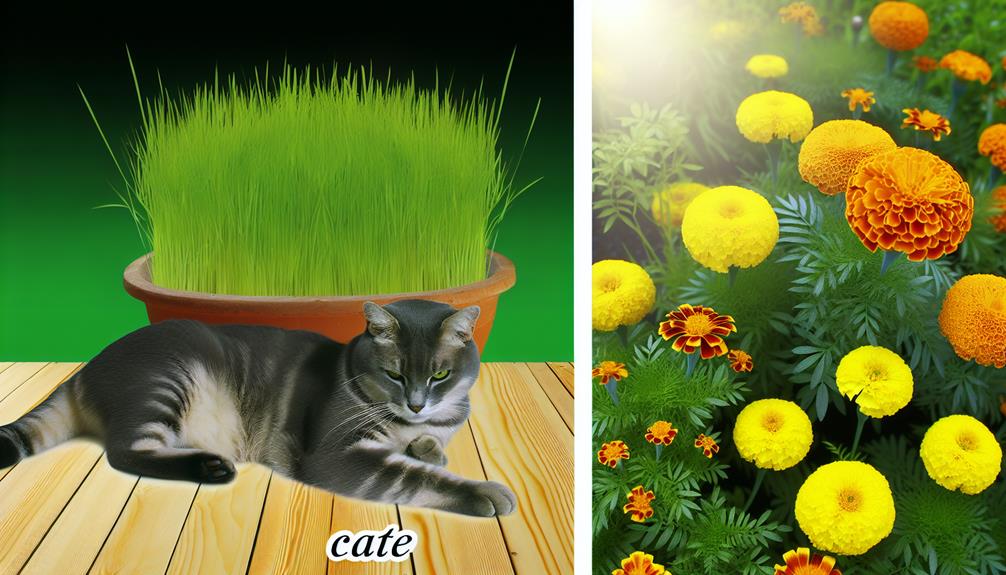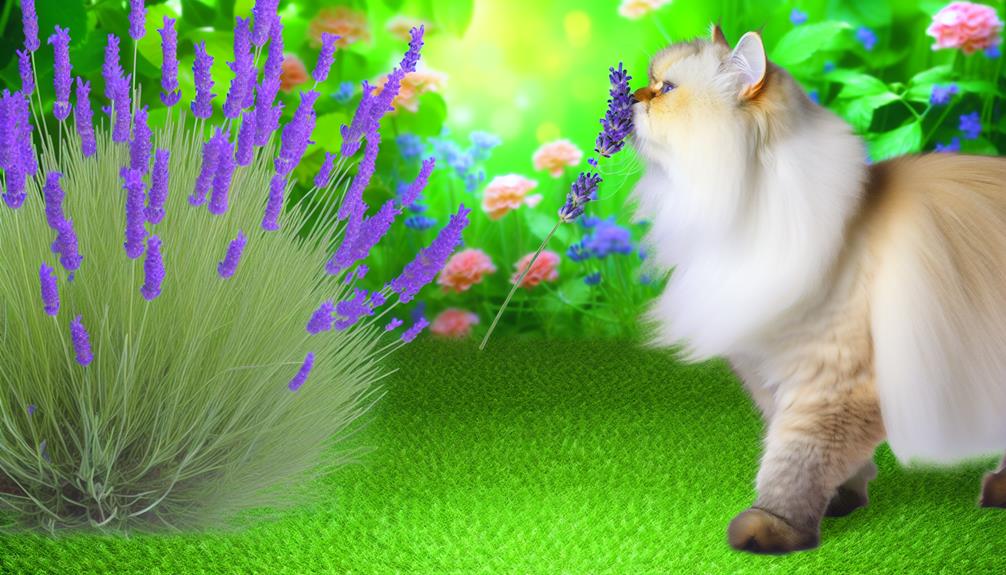When you think about using lavender around your home, you might wonder if it's safe for your feline friends. While lavender's calming properties can be beneficial, it contains compounds like linalool and linalyl acetate that can be toxic to cats. These substances can cause gastrointestinal distress and respiratory issues. So, how can you enjoy the soothing scent without putting your cat at risk? Understanding the balance between the benefits and potential hazards is key. Let's explore what you need to know to keep your pet safe and your home smelling wonderful.
Understanding Lavender
Lavender, a member of the Lamiaceae family, is renowned for its aromatic properties and is frequently utilized in both traditional and modern therapeutic practices. You'll find that lavender cultivation is quite meticulous, requiring a well-drained soil and full sunlight to thrive effectively. The plant's resilience makes it suitable for various climates, although it prefers temperate conditions. To achieve effective growth, it's vital to understand the specific requirements of different lavender varieties.
There are numerous lavender varieties, each with distinct characteristics and uses. For instance, Lavandula angustifolia, commonly known as English lavender, is prized for its high-quality oil and is often used in aromatherapy. French lavender, or Lavandula dentata, is more ornamental, with serrated leaves and a milder scent. Spanish lavender, Lavandula stoechas, features unique, pineapple-shaped flower heads and is often grown for decorative purposes rather than its essential oil.
When you're cultivating lavender, proper spacing is important to prevent fungal diseases, which can be a common issue. You should also consider that lavender requires minimal watering once established, as overwatering can lead to root rot. Pruning is another significant aspect of lavender cultivation, helping to maintain the plant's shape and encourage new growth.
Given lavender's extensive use in various domains, from essential oils to culinary applications, its cultivation demands an evidence-based approach to maximize its therapeutic benefits. Understanding these nuances helps you appreciate the diversity and complexity of lavender varieties and promotes successful cultivation practices.
How Cats React to Lavender
When considering the impact of lavender on feline health, it's vital to understand the physiological and behavioral responses cats exhibit. Cats possess an acute sense of smell, with approximately 200 million scent receptors compared to humans' 5 million. This heightened scent sensitivity means that even small amounts of lavender can elicit strong reactions. Feline preferences for or against certain scents are not just a matter of taste but are deeply rooted in their biological makeup.
Lavender contains linalool and linalyl acetate, compounds that are particularly potent for cats. When a cat sniffs lavender, you might observe behaviors such as sneezing, head shaking, or even pawing at the nose. These reactions are indicators that the scent is overwhelming or unpleasant to them. Cats may also exhibit avoidance behaviors, steering clear of areas where lavender is present. This is a direct consequence of their scent sensitivity and their instinctual drive to avoid potentially harmful substances.
Furthermore, ingesting or direct contact with lavender can stimulate a cat's vomeronasal organ, leading to drooling, increased salivation, and in some cases, gastrointestinal upset. It's worth noting that each cat's reaction can vary based on individual feline preferences and sensitivities. Some might tolerate the scent without immediate adverse reactions, while others could exhibit more pronounced signs of discomfort.
Understanding these reactions is vital for making informed decisions about using lavender in your home environment. By acknowledging the specific ways cats react to lavender, you're better equipped to create a safe and comfortable space for your feline companion.
Potential Risks of Lavender

Exposure to lavender can present several potential risks for cats, primarily due to its chemical constituents, linalool and linalyl acetate. These compounds, while generally safe for humans, are toxic to felines. Even small amounts can lead to lavender toxicity, making it vital to understand the implications of having lavender plants or essential oils in a household with cats.
When cats ingest or come into contact with lavender, their liver's limited ability to metabolize these compounds can lead to accumulation and subsequent toxicity. Cats lack certain liver enzymes, specifically glucuronyl transferase, which are essential for detoxifying substances like linalool and linalyl acetate. This enzymatic deficiency heightens the risk of adverse effects even with minimal exposure.
Topical absorption and inhalation are also concerning routes of exposure. Essential oils, when diffused, can create a hazardous environment for your feline companion. The respiratory system of cats is sensitive, and inhaling volatile compounds can lead to respiratory distress. Additionally, if a cat rubs against a surface with lavender oil, the oil can be absorbed through the skin, potentially leading to systemic toxicity.
Another risk factor involves the ingestion of lavender plants or products containing lavender. Curious cats may chew on lavender plants, ingesting both the leaves and flowers. This can lead to gastrointestinal distress and further complicate the situation.
Understanding these risks is important for ensuring cat safety. Lavender toxicity is a serious concern that requires preventative measures. By being aware of these potential risks, you can make informed decisions about the presence of lavender in your home, thereby prioritizing the health and safety of your feline friend.
Symptoms of Lavender Toxicity
When your cat is exposed to lavender, you might notice common toxicity signs such as vomiting and diarrhea, indicating gastrointestinal distress. Behavioral changes like lethargy, refusal to eat, or agitation are also critical indicators. It's important to recognize these symptoms early to prevent severe complications.
Common Toxicity Signs
Lavender toxicity in cats often manifests through a variety of clinical signs that can serve as vital indicators. When your feline friend experiences lavender exposure, it's important to recognize symptoms promptly due to their heightened feline sensitivity. Cats lack certain liver enzymes that help detoxify specific substances, making them particularly vulnerable.
Common signs of lavender toxicity include gastrointestinal distress, such as vomiting and diarrhea. You might also notice excessive drooling or hypersalivation. Neurological symptoms can arise, including lethargy, ataxia (loss of coordination), and even seizures in severe cases. Additionally, respiratory issues like coughing and rapid breathing can occur. Monitoring these signs can be life-saving.
Here's a quick reference table to help you identify these symptoms:
| Symptom Type | Clinical Signs |
|---|---|
| Gastrointestinal | Vomiting, Diarrhea |
| Neurological | Lethargy, Ataxia, Seizures |
| Respiratory | Coughing, Rapid Breathing |
| Oral | Hypersalivation |
If you observe any of these signs, seek veterinary attention immediately. Early intervention can prevent serious complications and improve the prognosis. Understanding these symptoms can help you act swiftly, ensuring your cat's safety and well-being. Always be vigilant about lavender exposure, considering their acute feline sensitivity.
Behavioral Changes Observed
Recognizing the clinical signs of lavender toxicity is paramount, but understanding the associated behavioral changes can offer additional insights. When your cat is exposed to lavender, you might notice behavioral shifts that signal distress. These feline reactions often manifest as noticeable alterations in their usual demeanor. For instance, a typically playful and sociable cat might become lethargic or unusually withdrawn.
Hyperactivity or agitation is another common behavioral change. If your cat suddenly starts pacing or displays restlessness, it could be an early indicator of lavender toxicity. Additionally, increased vocalization, such as excessive meowing or growling, can be a sign of discomfort or pain.
Uncharacteristic aggression is another key behavioral shift to watch for. Cats experiencing lavender toxicity may react defensively or show irritability, even in response to routine interactions. You might also observe obsessive grooming or scratching, which can be indicative of underlying discomfort.
Gastrointestinal Distress Indicators
Gastrointestinal distress is a prominent symptom of lavender toxicity in cats, warranting immediate attention. If your cat ingests lavender, you might notice gastrointestinal upset manifesting as vomiting or diarrhea. These symptoms are your cat's way of expelling the toxin from its system. Pay close attention to the frequency and severity of these episodes; persistent vomiting and diarrhea can lead to dehydration and further complications.
Nausea symptoms often accompany gastrointestinal distress. You might observe your cat drooling excessively, licking its lips, or making repeated swallowing motions. These are classic indicators of nausea. Additionally, your cat may exhibit a decreased appetite or complete food aversion, both of which can greatly impact its overall health if not promptly addressed.
If your cat demonstrates these gastrointestinal symptoms, it is vital to consult a veterinarian immediately. The vet might perform a thorough examination, including blood tests and possibly imaging, to assess the severity of the toxicity and rule out other potential causes. Early intervention is important to mitigate the adverse effects of lavender toxicity and guarantee your cat's swift recovery. Remember, prompt action can make all the difference in your cat's well-being.
Benefits of Lavender for Cats

When used correctly, lavender can offer some benefits for cats, primarily due to its calming aromatic effects and its role as a natural pest repellent. You should always guarantee the lavender used is in forms that are safe for feline exposure, such as diluted essential oils or dried lavender in small, controlled amounts. Evidence suggests that these applications can help reduce stress and deter pests without causing harm.
Calming Aromatic Effects
Lavender's calming aromatic effects can offer various benefits for cats, particularly in reducing stress and anxiety. Aromatic therapy, which utilizes essential oils like lavender, has been shown to have significant calming effects on felines. The calming scents of lavender can help soothe a cat's nervous system, promoting relaxation and reducing symptoms of anxiety. For example, in situations like vet visits, thunderstorms, or new environments, diffusing lavender oil in the air can create a more serene atmosphere for your cat.
From a clinical standpoint, the efficacy of lavender in reducing feline stress is backed by evidence-based research. Studies indicate that the linalool and linalyl acetate compounds in lavender interact with the central nervous system, modulating neurotransmitter activity to induce a state of calm. It's crucial, however, to use lavender in moderation and guarantee it is properly diluted, as cats are highly sensitive to concentrated essential oils.
When using lavender for aromatic therapy, consider an essential oil diffuser placed in a well-ventilated area. This method allows the calming scents to disperse gently, providing therapeutic benefits without overwhelming your cat's sensitive olfactory system. Always monitor your cat for any adverse reactions and consult your veterinarian for personalized advice.
Natural Pest Repellent
One remarkable benefit of lavender for cats is its natural pest repellent properties. Lavender oil contains compounds like linalool and linalyl acetate, which are effective in pest control. These compounds disrupt the neurological pathways of insects, making your home less attractive to fleas, ticks, and mites.
When you use lavender oil as a pest repellent, it's essential to dilute it properly. Undiluted essential oils can be toxic to cats, so always mix lavender oil with a carrier oil, such as coconut or olive oil. A recommended ratio is one drop of lavender oil to a teaspoon of carrier oil. Apply this mixture sparingly on your cat's fur, avoiding sensitive areas like the face and paws.
Clinical studies have shown that lavender oil not only repels pests but also possesses antifungal and antibacterial properties. This can help prevent skin infections that pests might introduce. However, always consult your veterinarian before incorporating lavender oil into your cat's pest control regimen to verify it's safe for your specific pet.
Safe Ways to Use Lavender
Incorporating lavender into your cat-friendly environment requires careful consideration to confirm their safety. While lavender usage can offer various benefits, it's paramount to recognize the potential toxicity of essential oils to felines. Cats lack certain liver enzymes necessary to metabolize compounds found in essential oils, making them particularly vulnerable.
To safely use lavender, consider employing dried lavender flowers instead of essential oils. Dried lavender can be placed in sachets or potpourri bowls, which can provide a mild, calming scent without directly exposing your cat to harmful compounds. Confirm these are placed in areas inaccessible to your cat to prevent ingestion.
If you prefer using essential oils, opt for a highly diluted solution. A concentration of less than 1% lavender essential oil mixed with a carrier oil, such as coconut or olive oil, can reduce risks. Apply this solution sparingly and only in well-ventilated areas, confirming your cat has the option to leave the room if the scent becomes too overwhelming.
Another safe method involves using lavender-infused products specifically designed for pets. These formulations are typically crafted with pet safety in mind, incorporating non-toxic levels of lavender. Always check product labels and consult with your veterinarian to confirm their suitability for your cat.
Additionally, diffusers can be used with caution. Confirm the diffuser is placed in a location your cat cannot access and operates for short durations. Always monitor your cat for any signs of respiratory distress or allergic reactions, such as coughing, sneezing, or excessive grooming.
Alternatives to Lavender

Although lavender offers various benefits, it's not always the safest option for cats. Cats have unique metabolic pathways that make them particularly sensitive to certain compounds found in lavender, such as linalool and linalyl acetate, which can lead to toxic reactions. Fortunately, there are several herbal alternatives and safe plants you can evaluate that provide similar therapeutic benefits without putting your feline companion at risk.
One of the most recommended herbal alternatives is chamomile. Chamomile contains apigenin, an anti-inflammatory compound that can help soothe anxiety and promote relaxation in both humans and animals. It's also generally regarded as safe for cats when used properly.
Another excellent option is valerian root. Valerian root has been extensively studied for its sedative properties and is often used to alleviate stress and anxiety. Valerian is known to be well-tolerated by cats and can even stimulate a playful response similar to catnip.
Speaking of catnip, this plant is a classic go-to for feline enrichment. Catnip contains nepetalactone, which can induce euphoria and promote physical activity, making it both a safe and enjoyable alternative for your cat.
Calendula, known for its wound-healing properties, can be another safe plant to evaluate. It has antimicrobial and anti-inflammatory effects, making it useful for minor skin irritations and promoting general skin health.
Lastly, evaluate using lemon balm. This plant has mild sedative effects and is known for its safety profile in cats. Lemon balm can help manage anxiety and digestive discomfort without the risks associated with lavender.
Conclusion
To sum up, while lavender has potential benefits, its risks to cats cannot be ignored. With compounds like linalool and linalyl acetate posing toxicity threats, careful use and monitoring are essential. Isn't your feline's health worth the extra precautions? Opt for dried lavender flowers or highly diluted oils, ensuring they're out of reach. Always observe for signs of discomfort or allergic reactions. With expert knowledge and evidence-based care, you can safeguard your cat's well-being.
